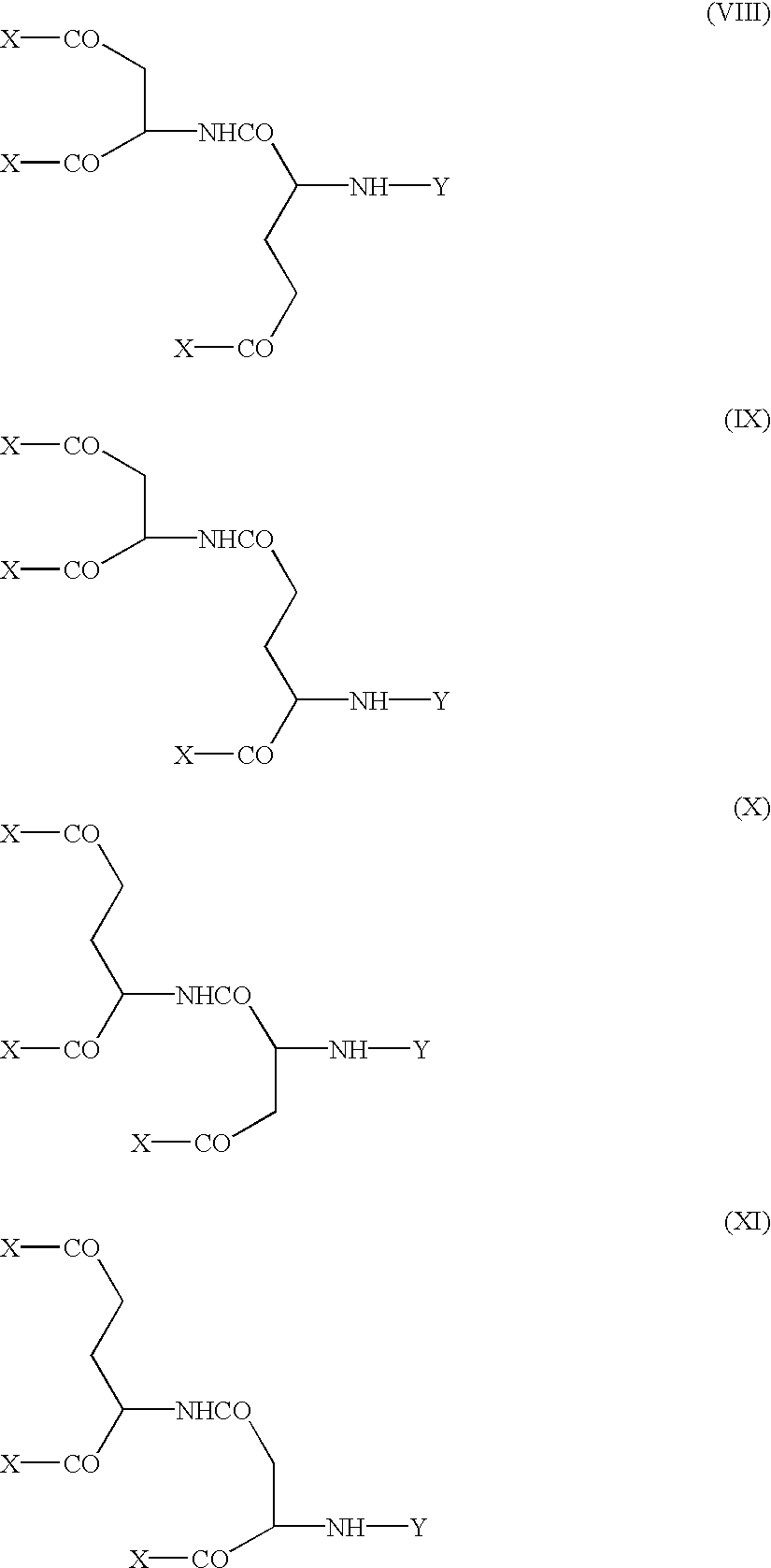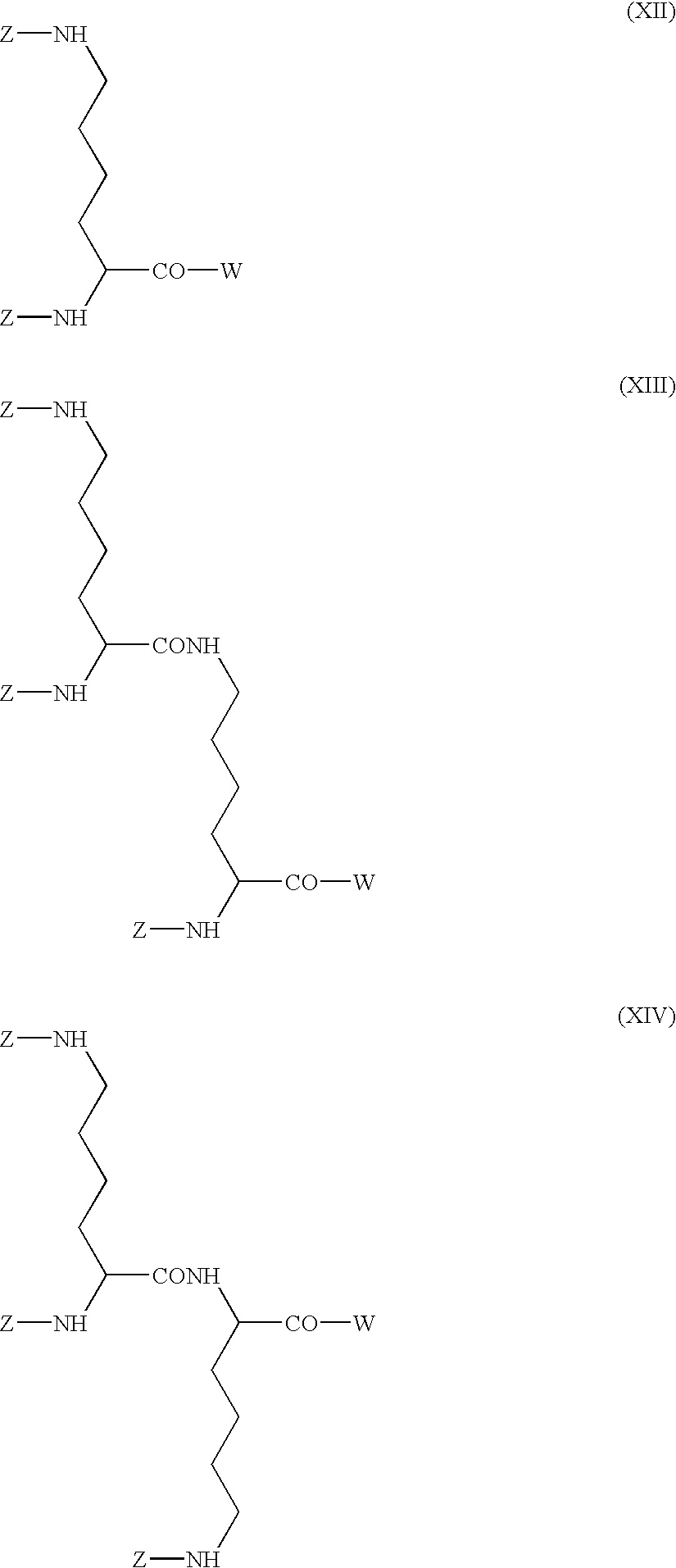Modified physiologically active proteins and medicinal compositions containing the same
- Summary
- Abstract
- Description
- Claims
- Application Information
AI Technical Summary
Benefits of technology
Problems solved by technology
Method used
Image
Examples
example 1
Production of (Gal).sub.3 -rhIL-2
An rhIL-2 solution (39 ml) dissolved in a 50-mM acetate buffer (pH 5.0) containing 0.25-M NaCl was applied to a Sephadex G-25 column (supplied by Pharmacia) which had been equilibrated with a 200-mM Tris-hydrochloride buffer (pH 7.5), and was eluted with the above-mentioned buffer. The elute was monitored at an absorbance of 280 nm to obtain a protein elute fraction (48 ml). The protein of this elute fraction was adjusted to a concentration of 5 .mu.M (330 ml).
To this elute fraction was added a branched Gal ligand ((Gal).sub.3, 472 mg) formed according to the method of Sato et al. (PCT / JP / 95 / 00298) as shown in FIG. 1.
To this reaction solution were added 60 U of a transglutaminase derived from microorganisms, and the mixture was incubated overnight at room temperature.
The reaction solution was preliminarily treated with a "Sep-Pak C8 Cartridge" (supplied by Waters), and then purified several times through reversed-phase HPLC using a "YMC-Pack C8-AP" c...
example 2
Production of PEG12, (Gal).sub.3 -rX2-IL-2
(1) Production of PEG12-rX2-IL-2
A 5-milliliter solution of rX2-IL-2 (fusion protein obtained by adding a P-K-P-Q-Q-F-M amino acid sequence to the N-terminus of hIL-2) prepared by the method of Sato et al. (PCT / JP / 95 / 00298) was applied to a Sephadex G-25 column (supplied by Pharmacia) which had been equilibrated with a 100-mM Tris-hydrochloride buffer (containing 10-mM CaCl.sub.2, pH 7.5), and was eluted with the above-mentioned buffer. The elute was monitored at an absorbance of 280 nm to obtain a protein elute fraction (6 ml). The protein of this elute fraction was adjusted to a concentration of 25 .mu.M / ml (10 ml).
To this elute fraction was added polyethylene glycol alkylamine (formula (2-3) in FIG. 2, PEG12, average molecular weight 12 KDa, 750 mg) prepared by the method of Sato et al. (PCT / JP / 95 / 002980) as shown in FIG. 2.
To this reaction solution were added 2 U of a transglutaminase derived from the guinea pig liver (supplied by Sigma),...
example 3
Synthesis of ((GalNAc).sub.3 (refer to FIG. 3))
(1) Synthesis of Compound (4)
Synthesis of Compound (4) was conducted upon improving the method of Yamada et al. (Japanese Laid-Open (Kokai) No. 202,085 / 1993). Five-hundred grams (2.96 mols) of 2-[2-(2-chloroethoxy)ethoxy]ethanol (Compound (1)) were added to a mixed solution of 596 g (3.22 mols) of potassium phthalimide and DMF (3.5 liters), and the mixture was stirred in an oil bath (100.degree. C.) for 17 hours while being heated. The reaction solution was cooled to room temperature, and an insoluble matter was filtered. The filtrate was concentrated under reduced pressure. The residue was extracted with methylene chloride (300 ml) , and the solvent was distilled off to obtain 895.6 g of Compound (2) as a yellow oil (crude product).
The resulting crude product was dissolved in EtOH (14 liters), and 198 ml (3.27 mols) of 80-% hydrazine monohydrate were added thereto. Then, the mixture was heat-refluxed for 2 hours while being stirred wit...
PUM
| Property | Measurement | Unit |
|---|---|---|
| Time | aaaaa | aaaaa |
| Molecular weight | aaaaa | aaaaa |
| Affinity | aaaaa | aaaaa |
Abstract
Description
Claims
Application Information
 Login to View More
Login to View More - R&D
- Intellectual Property
- Life Sciences
- Materials
- Tech Scout
- Unparalleled Data Quality
- Higher Quality Content
- 60% Fewer Hallucinations
Browse by: Latest US Patents, China's latest patents, Technical Efficacy Thesaurus, Application Domain, Technology Topic, Popular Technical Reports.
© 2025 PatSnap. All rights reserved.Legal|Privacy policy|Modern Slavery Act Transparency Statement|Sitemap|About US| Contact US: help@patsnap.com



